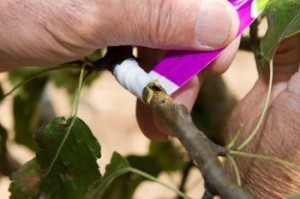I’ve been doing some research about grafting lately. And, believe me, research is needed because gardening is not my thing. Maybe it will be my thing when my kids are a bit older. But, as I look out my back windows and see my garden overtaken by grass and weeds, I have to remind myself that I’m growing kids not prize-winning tomatoes.
So, here’s what I’ve learned so far:
Grafting by a master gardener takes two separate plants and binds them into one so that they now grow together as one plant, a more beautiful plant at that. You could graft two apple trees to make one tree that produces two different kinds of apples. Or, you could graft rose bushes to produce a plant with many varied colored flowers. Rather than create a genetically new plant variety through grafting, the plant actually keeps the two separate genetic codes but grows together as one, maintaining both the two original identities as well as creating a new identity as one.
Besides producing an interesting or more beautiful plant, grafting is also sometimes necessary. For example, if a plant does not have a good root system, it will die. Grafting it into a larger, more established tree which will become its root system will save the plant. Furthermore, grafting enables a plant which is no longer fruitful but has deep roots to become fruitful and useful again.
In order for grafting to be successful, 4 conditions must be met:
- The two plants must be compatible to begin with. And, sometimes the only way of knowing this is through research and trial by a master gardener.
- Each plant must be at the proper physiological stage. The plant grafted in should have buds that are present but dormant. The plant receiving the graft must be healthy and have strong roots—often determined by the quality of the soil surrounding the plant since you can’t actually see the roots. The best time of year to graft plants is late winter, on the cusp of spring when new growth is close. If the plant to be grafted in has a disease, the receiving plant will be affected and the graft a fragile one. But, if the receiving plant is healthy and the graft is done well, success can still be experienced.
- The cambial layers of both plants must meet; they cannot simply have their bark touching. They cannot be attached on the surface; rather the plants have to be attached on a deeper level, under the bark, a process that is painful for both plants but absolutely necessary. Without the peeling back of the top layer and a connection at the core, the graft simply won’t take.
- The graft union must be kept moist and warm until the wound has healed. It must be watered, nurtured, cared for carefully and regularly until the wound has healed. If you neglect the graft, the wound may not heal. And, even if the plants are able to grow, the growth will be poor and the scars on the plants apparent.
Now, read this:
“But some of these branches from Abraham’s tree—some of the people of Israel—have been broken off. And you Gentiles, who were branches from a wild olive tree, have been grafted in. So now you also receive the blessing God has promised Abraham and his children, sharing in the rich nourishment from the root of God’s special olive tree.” (Romans 11:17, New Living Translation)
Do you get that? Do I really get that? As a Gentile believer in Christ, I have been grafted into God’s family, a full member of God’s family, receiving the blessing promised to His chosen people. I grow there; I bear fruit there; and I am pruned there as all branches should be—not as a punishment but as a way to keep me fruitful and productive.
Now read this:
“God decided in advance to adopt us into his own family by bringing us to himself through Jesus Christ. This is what he wanted to do, and it gave him great pleasure. So we praise God for the glorious grace he has poured out on us who belong to his dear Son.” (Ephesians 1:5-6, New Living Translation)
Do you see the word synonymous with being grafted in—adopted.
Now, read again about the gardener’s rules of grafting and consider not only our spiritual adoption but our adoptions as lived out in our families on earth.
God’s word is so rich, so absolutely applicable to our lives.
We are grafted in. We are grafted into God’s family, an adoption process initiated by our Father and one that brings Him great pleasure. He has poured out His glorious grace on us and made us—even in our dead state—His own, a coheir with His son.
My earthly family is also grafted. We believed God was calling this rooted family to become fruitful again. We researched and prepared and then had to simply take the leap of faith. We peeled back our layers as our daughter was forced to peel back her own. No doubt, this was not comfortable for either of us. But, comfort without roots is short lived. And, comfort without fruit is purposeless. We’re still quite aware of this new graft and daily caring for the wound, nurturing both the branches (new and old) and the roots of all of them and keeping the wound moist and warm in hopes that it will heal in time and produce a fantastic tree, one with two distinct identities—Chinese and American—but one root system, one life together.
Is this easy? No. It can be scary and overwhelming. But, not only is the end worth it all, but the process of getting there is worth it as well.
_______________________________

Forever changed by our experience of being adopted and adopting, Kelly is a stay-at-home mom/manager to 4 children and a professional juggler, juggling her calling as wife and mother with her secondary callings (editing and serving adoptive families through The Sparrow Fund). You can learn more about their adoption story, how they’ve been changed, and what life for them looks like on their personal blog, My Overthinking (where she’s going to have some super sweet giveaways this month, by the way).

